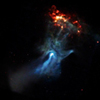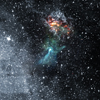CXC Home | Search | Help | Image Use Policy | Latest Images | Privacy | Accessibility | Glossary | Q&A
Tour of PSR B1509-58
Quicktime MPEG
A small dense object is responsible for the remarkably complex and intriguing structures seen in this image from the Chandra X-ray Observatory. At the center of this image is a very young and powerful pulsar, known as PSR B1509-58. Pulsars are rapidly spinning neutron stars that are created when massive stars run out of fuel and collapse. This pulsar is spewing energy out into space and creates this beautiful X-ray nebula, including a structure that resembles a hand. Finger-like structures extend to the upper right, apparently transferring energy into knots of material in a neighboring cloud of gas and dust that is seen in other wavelengths. This makes these knots glow brightly in X-rays, which is why they appear red and orange in this Chandra image. Astronomers think that this pulsar is about 1700 years old and lies about 17,000 light years from Earth.
[Runtime: 00:59]
Quicktime MPEG
A small dense object is responsible for the remarkably complex and intriguing structures seen in this image from the Chandra X-ray Observatory. At the center of this image is a very young and powerful pulsar, known as PSR B1509-58. Pulsars are rapidly spinning neutron stars that are created when massive stars run out of fuel and collapse. This pulsar is spewing energy out into space and creates this beautiful X-ray nebula, including a structure that resembles a hand. Finger-like structures extend to the upper right, apparently transferring energy into knots of material in a neighboring cloud of gas and dust that is seen in other wavelengths. This makes these knots glow brightly in X-rays, which is why they appear red and orange in this Chandra image. Astronomers think that this pulsar is about 1700 years old and lies about 17,000 light years from Earth.
[Runtime: 00:59]
(Credit: NASA/CXC/SAO/P.Slane, et al.)
Sequence of PSR B1509-58 Images
Quicktime MPEG
The sequence of images begins with an infrared view of the area around the pulsar PSR B1509-58. The view then zooms into an optical image, which shows a surrounding cloud of gas. Next, a composite image with optical and Chandra X-ray data (in color) shows the effects of an energetic wind powered by the pulsar. The X-ray emission results from very energetic electrons spiraling in a magnetic field. Finger-like structures extend to the upper right and energize knots of material in the gas cloud. The sequence ends with an X-ray/radio composite and a final image that includes the three wavelengths of X-ray, radio, and infrared emission.
[Runtime: 00:22]
View Stills
Quicktime MPEG
The sequence of images begins with an infrared view of the area around the pulsar PSR B1509-58. The view then zooms into an optical image, which shows a surrounding cloud of gas. Next, a composite image with optical and Chandra X-ray data (in color) shows the effects of an energetic wind powered by the pulsar. The X-ray emission results from very energetic electrons spiraling in a magnetic field. Finger-like structures extend to the upper right and energize knots of material in the gas cloud. The sequence ends with an X-ray/radio composite and a final image that includes the three wavelengths of X-ray, radio, and infrared emission.
[Runtime: 00:22]
View Stills
(Credit: X-ray (NASA/CXC/SAO/P.Slane, et al.); Optical (WFAU/SuperCOSMOS); Infrared (2MASS/UMass/IPAC-Caltech); Radio (Molonglo Obs. Synthesis Tel.))
Size Comparison Between PSR B1509-58 and Crab Nebula
Quicktime MPEG
This animation shows how radio jets may be suppressed in the micro- quasar GRS 1915. Material is being pulled from a red companion star into a black hole via a blue, rapidly rotating disk. The animation begins with a jet blowing material away from the black hole. Later, when the disk is heated by powerful radiation from close to the black hole, a wind is driven off the disk. As the wind strengthens, the jet apparently is shut down because the wind deprives the jet of material that would otherwise have fueled it.
[Runtime: 00:07]
View Stills
Quicktime MPEG
This animation shows how radio jets may be suppressed in the micro- quasar GRS 1915. Material is being pulled from a red companion star into a black hole via a blue, rapidly rotating disk. The animation begins with a jet blowing material away from the black hole. Later, when the disk is heated by powerful radiation from close to the black hole, a wind is driven off the disk. As the wind strengthens, the jet apparently is shut down because the wind deprives the jet of material that would otherwise have fueled it.
[Runtime: 00:07]
View Stills
(Credit: B1509-58 (NASA/CXC/SAO/P.Slane, et al.); Crab (NASA/CXC/SAO/F.Seward et al.))
Return to PSR B1509-58 (April 3, 2009)





